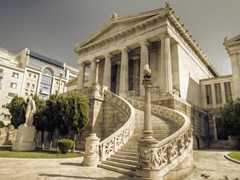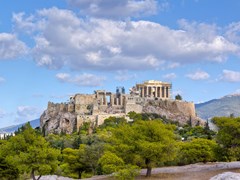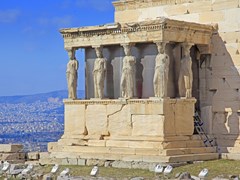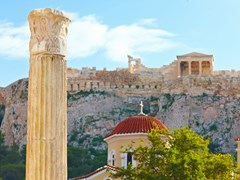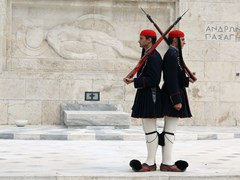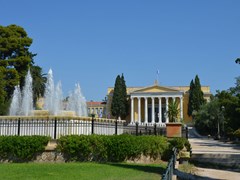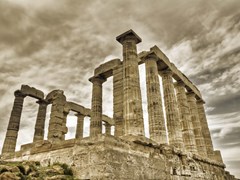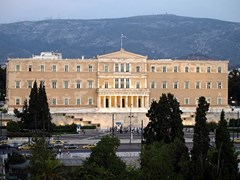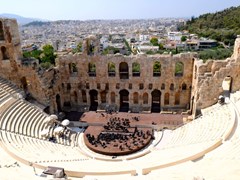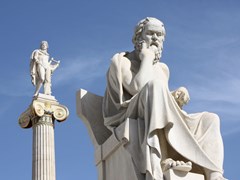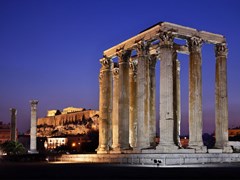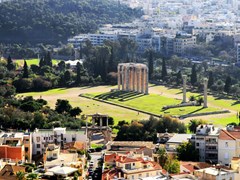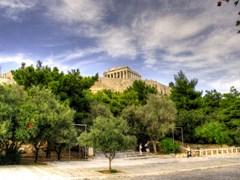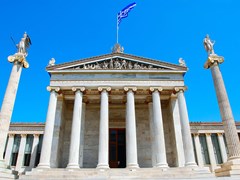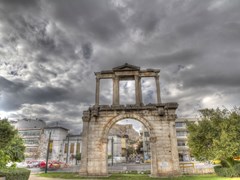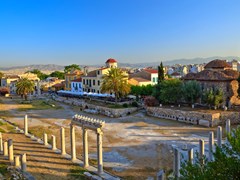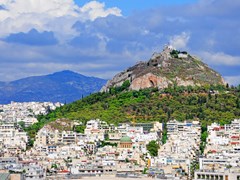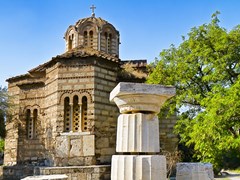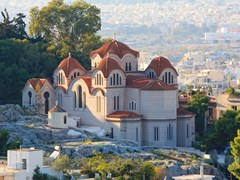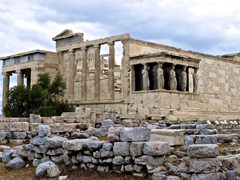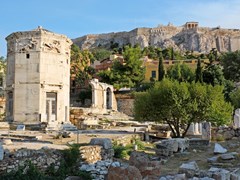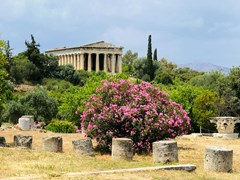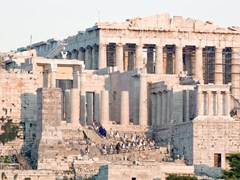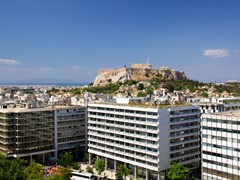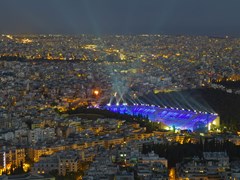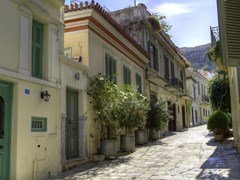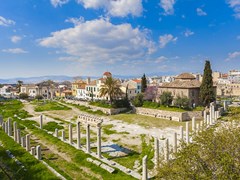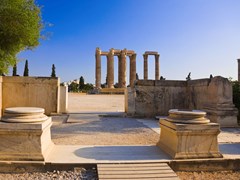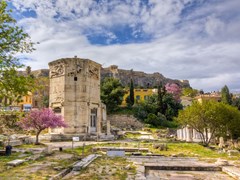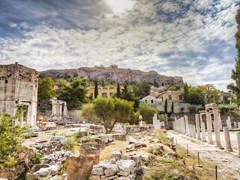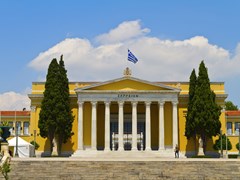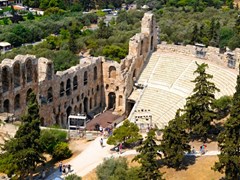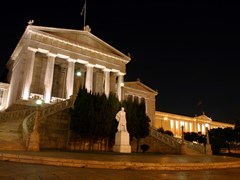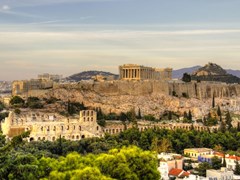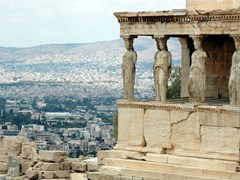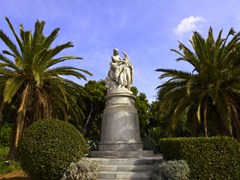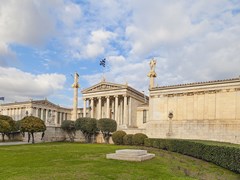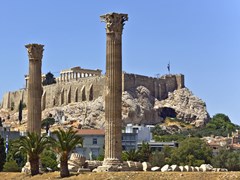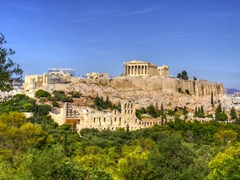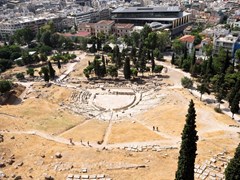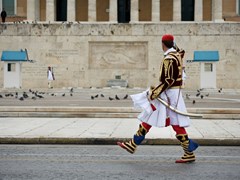Athens – Earth’s precious diamond ring
Attica peninsula - a small triangle at the edge of Central Greece – world widely known; dominated by famous Athens, surrounded by its small satellite -like cities.
From a distance, or top Athens looks like individual city , and sometimes , thanks to the magic of sunlight reflecting off hundreds of thousands of its windows , like a sea of shimmering reflections.
From distance, city seems rather impersonal. Yet, it is worth discovering its small charms that immediately captivate you. You can easily make a trip back in time with a walk around few archaeological sites and historical places. If, in addition, you are somewhat familiar with the history of Athens, you will tremble. Treading in the footsteps of thousands of ancestors, walking on the ground, where they had walked, you feel unique sensations. And, knowing that this is probably the only capital city where you can experience the vibrant nightlife, and then, just a few kilometers away, swim in the beautiful sea, the combination of all this make anyone fall in love with this city even more.
Athens it is. Distant, yet, addictive - never leaving mistress. Hidden beauty, yet, opens up at the gaze of your eyes – a variety that fascinates. It is the already familiar grey face of the city that will let you discover Athens.
Athens (Αθήνα) - the capital of Greece, Attica prefecture, county of Athens. Athens is the economic, cultural and administrative center of the country.
History of Athens
The first evidence of human habitation in Athens belongs to Neolithic era: approximately 4th millennium BC. In any case, this is mainly indicated by several archaeological artifacts that have been found during the excavation of Acropolis.
During the Mycenaean period (13th century BC) Athens has been the political and cultural center of Greece, as evidenced by the remains of Cyclopean walls around the Acropolis, and the route of the royal palace, and, of course, through the great number of legends and myths that have survived up until today.
According to legend, Athens was inhabited by Ionians, taking its name from Jonah - the son of the god Apollo. The greatest kings of Athens: Kekrop, Erechtheus, Aegeus and Theseus, contributed significantly for the city’s development. The site of the royal palace hosts today the famous temple of Erechtheion. The principal founder of the city is Theseus, who freed the Athenians from dues, which they paid to the king of Crete - Minoa. Thanks to him, disparate Athenian state-policies have been united. After the death of Theseus Institute of royal power gradually weakens and, in the end, control of the city goes to several aristocratic families. Up to about 1000 BC Athens was ruled by Ionian kings. Even at that time the city was the political and cultural center. But over time, power of the kings weakened and Athens was under the command of several aristocratic families. In particular , during this period, one of the city’s leaders- Draco, founded the first recorded laws , the severity of which were proverbial in ancient times ( Draconian ) since the most common form of punishment in them was the death penalty. In 594 BC ruler of Athens, was elected one amongst the "seven wise men" of ancient Greece- Solon. He reformed the existing laws; abolished slavery dept and gave Athens the national assembly, the constitution and the Supreme Court, laying the foundation of a limited democracy. In the year 560 BC came to power, the tyrant Pisistratus. The word "tyrant" at that time was understood as the person to concentrate the power in his own hands. Pisistratus was a very wise politician. He supported the poor, encouraged the development of arts and science. It was he, who erected the first temple complexes on Acropolis area. Later, however, based on a system of Solon, Cleisthenes completely overthrew generic tyranny and established democracy that proved a political system of Athens for most of the heyday of the city.
Meanwhile the Athenians could not be called civilians. They were at war with Persia, have made great strides in military strategy and built a powerful fleet, turning Athens into a powerful city-state.
In 431 BC between Sparta and Athens began the Peloponnesian War, which ended in total defeat for the Athenians, the decrease in population in half and reducing the fleet to ten ships.
However, despite all the disasters, Athens never stopped being a cultural center. Aristophanes writes comedies, Plato teaches in created by him Academy, Aristotle becomes the founder of formal logic.
In 338 BC Philip II of Macedon captures Athens and other Greek territory, replaced by his son, Alexander the Great . Athens then becomes part of the Roman Empire. City sends his teachers to Rome and takes the value of the second cultural center on the outskirts of the Empire. The Romans contributed to the architectural appearance of the city, erecting buildings standing to this day, which include the Triumphal Arch of Hadrian. After the fall of the Roman Empire begins the era of Christianity in 50 AD city is visited by the Apostle Paul to preach citizens. During the reign of the Byzantine Empire and the Crusades -Neo-Platonic philosophical schools closed by Justinian I, dungeons Acropolis transformed into the Christian church, and the sanctuary of Athena Parthenonas - into church of Virgin Mary.
Classic Ancient Athens
In 490 BC Persian King Darius decided to punish Athens for the support of another Greek city of Miletus during the uprising of the Greek cities in Minor Asia. Intelligent Persian army landed near the town of Marathon to Athens, where it was waiting for the Athenian forces under the leadership of strategist Miltiadis. There was a battle in which the Athenians won their first victory over the Persians. Ten years later, after the death of Darius, the Persians invaded Attica again-this time with greater force and directly under the authority of King Xerxes. After the legendary Battle of Thermopylae in which a small detachment of Spartans led by King Leonidas heroically held back the entire Persian army, giving time to gather the main Greek forces, the Persians came to Athens and completely destroyed all the temples of the Acropolis. The coup in the war took place after the sea battle of Salamina, which united Greek forces under the leadership strategist Themistocles the Athenian fleet, routed the Persians. A talented politician, Themistocles did much to Athens. He surrounded the city with strong walls, built the port of Piraeus and has ensured that Athens became a great sea power. However, the fate of his was sad. Unrecognized by the Athenians, he was forced to leave the city, he entered the service of the Persian king, where he was murdered by hired assassins. Finally expelled the Persians from the region of Attica strategist Kimon (his grave, which is preserved to this day, is in the area of the Acropolis).
Golden Age of Athens was in 5th century BC - During the reign of Pericles. At that time were built the greatest monuments of Ancient Greece - The Parthenon, the Propylaea of Acropolis of Athens, and others, and the city became the center of intellectual life. Flourish in art and philosophy - Anaksogor, Sophocles, Euripides, and Aristophanes and Herodotus doing their immortal works, Socrates lays the foundations of Western philosophy. But, despite the fact that the cultural heritage of this era and to this day has an impact on Western civilization, classical Athens period only lasted five decades.
After the capture of the city of Athens by the Turks became a province of the Ottoman Empire. In 1821 starts the Greek War of Independence. The first capital of Athens is the city of Navplion , and in the 1833 Athens proclaimed capital of the newly created Kingdom of Greece (at that time the city's population reached 5,000 people). In 1834 came to Athens a new Greek King Otto of Bavaria. The young king had the ambition to rebuild the city and restore it to its former glory. He then invited to Athens architects Leo von Klentse and Theophilus von Hansen and built several major streets in the neoclassical style , including Syntagma Square , Athens University , National Park , Exhibition Hall Zappeion .
In 1896, at the restored stadium of Panathinaikos - built of solid marble, were held the first modern Olympic games. And in 2004, it hosted the 28th Summer Olympic Games.
Modern Athens - a metropolis with ancient monuments, world famous for its "night life" and high level shopping centers
The City Name
In the ancient times the name of the city, for that matter, and most of the other cities of Greece, was used in the plural - Athens. In 1970, with the abandonment of katharevousa (Greek dialect), single number - Athena - became official. Although in Russian language as well as in English, the name of the city preserved in plural.
According to a myth, the city was named in honor of the virgin -warrior Athena, goddess of war and wisdom, patron of the arts , crafts , science and knowledge. The first king of Athens Kekrop (half-human, half- serpent) had to decide who would be the patron saint of the city. Two gods Athena and Poseidon, always competing in everything needed to make him a gift and the one who will make the best gift was to become the patron saint of the city. Then Poseidon, god of the sea, right in front of Kekropa struck his trident on a rock and outscored the crystal source . He stressed that thanks to his gift in the city will always be water and its inhabitants will never suffer from drought. But the water was a source of salt, like sea water, which commanded Poseidon. But after the shock of the land of Athenna - wonderful olive tree grew, which gave food, oil and wood for heating. Kekrop was impressed with the gift of Athena. Since then, the city bears the name of a beautiful goddess...
However, historians still have not come to a consensus. There are many other versions of the origin of the name of the city, even though this is - the most beautiful.
Architecture
The population of Athens, together with the suburbs is about 4 million people (as well as approximately 500,000 immigrants living impermanent), estimated for over a third of the entire population of Greece.
Center of ancient Athens was located around the Acropolis and and occupied Thissio and Plaka areas. These areas, together with an area of Syntagma and Kolonaki and hill Lycavitos today constitute the tourist center of the city. Monastiraki area directly under the walls of the Acropolis - the largest shopping area of the city.
The center of the modern city is Syntagma Square, where the former royal palace, Parliament and many buildings of the XIX century, built in a classical style. This building, University of Athens, located on Panepistimiou Avenue, the building of the National Library and the Academy of Athens, called «Athens Trilogy ".
The highest among modern architectural constructions of the capital since 1971, is the Athens Tower 1, which at the time of construction was the tallest building in the Balkan region, and today remains the only skyscraper in Greece.
More recently, Athens was a “famous” to its smog, lots of traffic and chaotic urban development. Now, with the implementation of projects for the Olympic Games 2004 in Athens - the city became a convenient place for tourists. Lovely and clean parks and roads, the modern subway, new roads, easily accessible airport, frequent and flawless pointers to help tourists enjoy visiting the city.
Take time to Athens! Meet with its sights! And you will never regret it! After all, the Acropolis, the Temple of Olympian Zeus and the treasures of the National Archaeological Museum - is this milestone in the history and culture of the Western world. Well, then you can continue your trip by visiting the islands of Saronic Gulf.
Acropolis
Acropolis in Greek – the edge of the city (the outskirts). Parthenon is considered as Acropolis’ pearl/gem. It is the city’s symbol and its main attraction. Therefore, Athens examination begins from Parthenon-Acropolis.
Read more ▼
In the middle of the 5th century BC in Athens according to Pericles initiatives was launched a large program of construction: three temples and monumental gates were built. A little later two theaters were - Dionysus and Herodes Atticus.
Propylaea - the entrance to the Acropolis. It is covered with marble gate with five passes in the middle, with both sides of a small six-column hall and side wings, porticos. The left wing is the Pinacoteca. At various times in Propileyah were located the residence of the archbishop, then a Crusader castle, then Turkish armory . In the XVII century, during the siege of the Acropolis during the war with Turkey, Propylaea got the kernel and the building was severely damaged. It was restored in the XIX century.
Parthenon - the symbol of Athens. The temple was built by the famous architect and sculptor Phidias in honor of the goddess Athena Parthena (Virgin). The temple was surrounded by 10 -foot Doric columns. The frieze of the temple scenes are from Greek myths and separate plots of Trojan War. To create the perfect visual experience in the construction of the temple proportions of «golden section" were equally distributed throughout the temple. Inside the temple there is a famous statue of Athena made of gold and ivory with Nike on her right hand. Statue participated in the annual Panathenaic procession, accompanied by the sacrifice of animals, musical and athletic contests. These days priests dress the statue in new clothes made by the best of skilled workers.
According to legend, the place where now stands the temple of Erechtheion, Poseidon and Athena entered the dispute over the right to be the patron of the city. The temple was named after the mythical Athenian king Erechtheus. Unlike other temples built in the classical period, the Erechtheion is asymmetrical with walls pierced through windows. The temple was erected at different levels and is divided into three separate rooms inside. Cornice of the portico on the south side of the church do not support columns and caryatids 6 - are statues of girls, made in the form of columns, the originals of which are now in the museum of the Acropolis. Inside the temple is a sanctuary of the mythical kings of Athens and Kekropa Erechtheus and Athena and Poseidon.
Acropolis Museum was built in 1878 to house exhibits from the excavations of the Acropolis. Of particular interest is the pediment of the temple Athena, where scenes from Gigantomachia and triumphant Athena and Zeus , who won the war. Here are stored the fragments of the frieze of the Parthenon pediment sculptures depicting scenes of Hercules fighting with various mythological creatures , surviving fragments depicting Panathenaic procession, and much more .
Below, on the rock under the walls of Acropolis, is the Theatre of Dionysus. On the top of a wonderful view.
A good view of Athens offers Areopagus cliff. However, it is not easy to get on. Stones, sanded down by millions of visitors, are quite slippery.
Entrance to Acropolis is not free. Tickets with validation of 4 days are being sold. The ticket includes visits to the Theatre of Dionysus, the Roman Agora, the ancient Greek Agora, Temple of Zeus, Hadrian's Library and the cemetery of ancient Athens – Ceramic.
The New Acropolis Museum
Climbing up the Acropolis, you will immediately notice the -art building of 300 m away from Acropolis itself, which stands out against the background of the overall landscape. This is the new archaeological museum of Acropolis.
Read more ▼
Old Archaeological Museum of Acropolis, built in 1874 , has long exhausted its exposition possibilities. In the late 80s, the Greek Government decided to build a new museum. The architects of the new building became famous Swiss architect Bernard Tschumi and Greek Michalis Fotiadis. Construction of the new museum began in November 2004 and was completed in 2009. The total project budget was 130 million Euros. The New Acropolis Museum provides about 4,000 pieces covering an area 14000 sqm which is almost 10 times greater than the area of the old Acropolis Museum (1450 meters). The museum is truly unique - it is built on an archaeological site. Therefore floors on the first floor are made of glass so you can see them.
Among the exhibits presented in the exhibition, a special place is occupied by a small (35 by 34 cm) piece of the frieze of the Parthenon - the image of foot and edge wear goddess Artemis, who was removed from Greece in the 19th century. A valuable piece was lent to Greek archaeological museum by University of Palermo. This fragment was joined by two other «fragments «of the Parthenon , which were kept in the Vatican Museums.
In total, the exhibition includes 74 exhibits that have been illegally removed from Greece and Italy, and later returned to his homeland.
Greece is seeking the return of the United Kingdom and the frieze of the Parthenon sculptures, exported in the 19th century by Lord Elgin and is the center of the British Museum collection. The surviving statues and reliefs of the Parthenon exhibited at the New Museum next to copies of those works that remain in the UK. This is to remind visitors of the struggle of Greece for the return of the «Parthenon Marbles ".
The Ancient Agora
Ancient Agora - a market area, which hosted the national court or assembly of free citizens in the open. Thus, upon conviction of the Agora Socrates was executed in prison. Shopping arcades, theaters, schools, and coin-yard are all located in here. One should follow Panathenaic way/ path from Acropolis in order to reach Agora.
Read more ▼
Amongst interesting buildings of the Agora is the Temple of Hephaestus (5th century BC) - the best-preserved ancient temple. It was a devoted patron of crafts Hephaestus and Athena. Common name of the temple - Theseyon , comes from the fact that in the sculptural decoration of the temple were used scenes from the life of the legendary king Theseus. During Byzantine times within the temple was located Christian Church, which operated until the XIX century. In 1950 , archaeologists restored stand Attala - a long two-storey portico , gift to the city of King Attalus .
Monastiraki
One of the oldest inhabited areas in Athens , bordered by Agora . Especially interesting to walk here on Saturday and Sunday. Around hum with life and works flea market on the street Ifestu . You can buy anything you want , from standard souvenirs to antique furniture.
Read more ▼
Generally in Monastiraki a mass of souvenir and antique shops are located. The main attraction is the street Adrian - The Church of St. Philip XVII century. At the entrance of the subway station " Monastiraki " is another architectural landmark - an ancient mosque , built in 1759 by Turkish commander Tsistaraki .
This area is widely adorable due to its unique atmosphere, not the sights only. You can just take a walk, watch the traders, listen to street musicians, have a cup of coffee in some cozy cafe.
Plaka
It is the most ancient Athenian neighborhood. It can be called as the most comfortable as well. Plaka is designed for walking, with narrow quiet streets; every step of you will lead to picturesque cafes, taverns, and friendly locals. Houses around are not so old, and - just "some” 200-300 years, yet, built on the foundations of ancient times.
Read more ▼
One should definitely visit Adrian street – it is considered the oldest within Athens. Then follows one of the busiest Athenian pedestrian street - Ermou Street. Here, you will find wide range of shops and clothing stores. Luxury brand boutiques are located at the beginning of the Street followed by high street brands
Walking down Ermou Street will lead you to Syntagma Square – the very heart of Athens city it is.
Syntagma Square’s main attraction - The Palace of Greek Parliament. Next is– the Tomb of the Unknown Soldier near which runs every hour shift honorary presidential guard. Interesting spectacle: evzony - the soldiers of the royal guard in elegant and unique clothes: fluffy short skirt, white tights, a vest with hand embroidery, a red beret. Of great interest are the shoes of those soldiers (evzony): huge clogs with pompoms on top (called tsarouchi) weigh no less than 5kg.
All evzony pass strict face control - each candidate must be not only well trained but have an attractive appearance and height of not less than 187 cm.
Especially solemn changing of the guard takes place during holidays. If you will be in Athens on Sunday – visit Syntagma square by 11:00 am to see the solemn duty shift units under the escort of a military band.
Syntagma Square (Constitution Square)
Underground stop close to square took its name - Syntagma Square is on the rating list of most unusual underground names in the world.
Read more ▼
In fact, underground stop is considered as a small archaeological museum. Outside the underground stop one can see a variety of unique items , hidden behind the glass. For example, a fragment of an ancient Athenian plumbing or ancient burial site. All the exhibited artifacts have been discovered here by the time laying two additional underground lines in preparation for the Olympic Games in 2004 , when engineers worked with archaeologists. The result of this collaboration: could pave the underground and, with thousands of priceless archaeological finds to keep. By the way, some underground stations have become real underground museums. In particular, various exhibits are on display at such stations as Acropolis and Monastiraki.
Panathenaic stadium
From Syntagma Square one can take a walk through the beautiful Royal Garden with ponds - numerous locals and visitors come to feed the ducks living here - and to be found in front of the most amazing sight of Athens – the Panathenaic Stadium.
Read more ▼
This massive structure was made entirely of white marble – built back in 329 BC
As expected, the stadium has not preserved to this day in its initial origin form, yet, in 1895 it was literally rebuilt. The project was founded by philanthropist George Averoff , whose statue now stands at the entrance of the stadium. Panathenaic stadium hosted the first modern Olympic Games organized in 1896.
Walking further down from Panathenaic stadium at the end of Anapavseos, is another attraction that deserves attention. This is the first Athenian cemetery called Keramikos – the place is really interesting and not gloomy at all.
The cemetery was opened in 1837 and became burial ground for local elite class. It is not surprising that every tomb here is a masterpiece. Particularly impressive is the mausoleum of the famous archaeologist H. Schliemann and his family. Therefore, the cemetery is often referred to as an open air museum.
The area of cemetery hosts three churches in total: two Orthodox and one Catholic.
Mount Lycabettus
Over urban neighborhoods of Athens, in the city center rises Mount Lycabettus ( Lycabettus ) . The mountain is 277 meters above sea level. It is a legendary place, with magnificent views of Athens, Acropolis, sea and the mountains surrounding the city.
Read more ▼
According to legend , the goddess Athena wanted her sanctuary to be located in Acropolis, close to the sky. One day she went to Mount Pentelikon and tore off a piece of rock to hoist it over Acropolis. At her return she was stopped by two crows which brought her bad news. Athena threw the rock and hurried after them. Conceived it has not carried out, and the mountain remained where it had been abandoned.
In ancient times, Lycabettus was covered with dense forest, but by the early 19th century not a single tree was on the mountain. Restore vegetation began only in 1880. Popular stories suggest it was once the refuge of wolves, possibly the origin of its name (which means "the one (the hill) that is walked by wolves").
At the top of the mountain is the Byzantine church of Saint George , also called the Church of St. Sidera. It was built in the XI-XII centuries. When the Byzantine Empire and Christianity have significantly strengthened their positions. In 1930, a fire destroyed the church, but in 1931 a snow-white church was completely restored. Lycabettus is an unusual sight on the Easter night: people are walking down with burning candles and it seems that Lycabettus is taped around with fire .
Lycabettus - a paradise for romantics. Pine and cypress trees, narrow paths and cozy wooden benches ... All of this will impress lovers of peace and quiet. No wonder the Lycabettus hill is also called Love.
On top of the mountain there is an outdoor theater. In the summer time, variety of concerts and theatrical performances are being held. Also, on top of the mountain is a cozy “Orizontes” restaurant, where you can relax and enjoy the magnificent scenery.
Mount Lycabettus has several paths and roads. It can also be reached from Kononaki area, on a cable car.
The Archaeological Museum of Kerameikos
Not far from the streets of Piraeus is the Archaeological Museum of Kerameikos . It is a small museum in the so -called external ceramic (a district of Athens). It is in this area, in ancient times, where numerous workshops engaged in the manufacture of the famous Attic pottery were arranged.
Read more ▼
To the main exhibit of the museum include a marble statue of a bull from the grave of Dionysus (the museum hosts the original piece, a copy has been set at the original place), 340 BC. Impressive collection of ancient Greek pottery is collected and exhibited within three museum halls. You can also see the decorations and household items of that era. The most famous exhibits also include the Early Geometric amphora (a characteristic style of Greek vase painting 900-700 years BCE), about 860-840 years BC. Also, remarkable is the black-figured lekythos vase (ancient Greek vase with a narrow neck on a small stem, used to store olive oil) painted by Amasis 550-540 years. BC, vase decorated with the figure of Dionysus and two saterous.
Tower of the Winds
This ancient building is located near the Roman Agora. It was built in the II century BC.
Read more ▼
It is an octagonal Pentelic marble clock tower that functioned as a hronologion or “timepiece”. The structure features a combination of sundials, water clock and wind vane.
The tower was constructed by Syrian astronomer Andronicus Cyrrhus.
The 12-metre-tall structure has a diameter of about 8 meters and was topped in antiquity by a weathervane-like Triton that indicated the wind direction. Below the wall painting are depicted the eight wind deities. In its interior, there was a water clock (or clepsydra), driven by water coming down from Acropolis. Recent research has shown that the considerable height of the tower was motivated by the intention to place the sundials and the wind-vane at a visible height on the Agora, making it effectively an early example of a clock tower.
Museum of Cycladic Art
Museum of Cycladic Art -Nicholas Goulandris - one of the largest museums of Athens. It was founded in 1986 on the basis of a private collection of Cycladic and Ancient Greek Art Goulandris family , one of the most wealthy and noble families of Greece.
Read more ▼
Nicholas and Dolly Goulandris began their collection in 1960 with the permission of the Greek government . The collection quickly became known among scientists for its rare exhibits. For the first time the collection has been exhibited at the Benaki Museum in 1978. In 1979-1983 exhibition was exhibited in major museums and galleries around the world. After the death of Nicholas Goulandris, his wife handed over a collection of Greek state for the creation of the museum.
The main building of the museum is located in the center of Athens, built in 1985, designed by the Greek architect Ioannis Vikelas. Over time, the exposition of the museum has expanded thanks to donations from collectors and new acquisitions. In 1991, the museum acquired a new building - the neo-classical Stathatos Mansion With its main building connecting the indoor glass transition.
The main collection of the museum is divided into three main areas: the Cycladic civilization, namely the early period of the Bronze Age, 3200-2000 BC Cycladic marble figurines , statuettes affect its elegance , simplicity and perfection ; ancient Greek art, the 2nd millennium BC to the 4th century BC , the art of ancient Cyprus from the Neolithic to the early Christian period , the 4th millennium BC - 6th century BC This is one of the most comprehensive collections of Cypriot antiquities in the world.
The museum runs a great gift shop where you can buy excellent copies of the exhibits.
The Benaki Museum
Benaki Museum- in Athens- is one of the oldest museums in Greece. It was founded in 1930 by Antonis Benakis as an honor to his father Emmanuel Benakis. The museum is hosted in family’s neoclassical style mansion, which was built in 1867. It was only in April of 1931 that the museum was open to public.
Read more ▼
His collection, which became the basis of the museum, Benakis (Antonis) collected over 35 years and handed over to the state under the condition that it will be exhibited in the museum. He was also the head of the museum until his death in 1954
The museum contains exhibits that cover the period from prehistoric times to the present day. In addition to the extensive collections of Greek art, the museum also has a large collection of Asian art. Initially, the collection of exhibits of Islamic art, Chinese porcelain and toys were presented in separate sections of the museum. In 2000, after a global restoration, were established museums satellites dedicated to specific topics , such as the Museum of Islamic Art in Ceramics Gallery, Nikos Hadzikiriakos - Ghica , a famous Greek painter , in Kolonaki , a separate exhibition of the collection of children's toys , etc. This allowed the main museum to focus on Greek culture.
The museum exhibits a variety of Paleolithic and Neolithic artifacts related to the Minoan and Mycenaean civilizations, products of early Hellenistic period. Ceramics, metal and wood, old icons and church plates, gold jewelry, textiles, paintings, sculptures, engravings, and other interesting artifacts allow the visitor to make a journey into the world of ancient Greece and trace its history to the present day. The museum also hosts work of the famous Greek painter El Greco.
“Attica” Zoo
Zoological Park «Attica " - a private institution. It is situated on the outskirts of Athens in an area of 20 hectares. First, it was created as Bird Park. At that time, a collection of birds that live in here considered as the third largest in the world and hosted more than 1000 birds of 300 different species.
Read more ▼
In April 2001 a new section of "The World of Reptiles” was opened, here one can see the crocodiles, pythons, boas, and other reptiles. In July 2002 there was the section of “Greek fauna” with brown bears, foxes, wild cats, lynx, wolves, etc. In February 2003, added the "African savannah” with giraffes, zebras, antelopes. Also, there are jaguars, llamas, snow leopards, white lions and other mammals. In 2003, there were monkeys in the zoo. Since then, the zoo has increased its population of interesting and rare animals.
In 2010, the zoo opened the Dolphinarium, where you can not only admire the dolphins and sea lions, but also watch the show with their participation.
Zoological Park “Attica” is considered one of the most visited in the world and is open all year round for visitors. It is a member of the European Association of Zoos and Aquariums.
Gekatompedon
Gekatompedon - one of the oldest temples of Acropolis of Athens. The name of the church is linked to the size of its intact (the inside of the church) - 100 ft (32.8 m ) long and 50 feet ( 16.4 m ) wide. Gekatompedon translated literally means "the one of 100 feet”.
Read more ▼
Temple built in the early 6th century BC, during the reign of Pisistratus, the site of the ancient Mycenaean Palace (14th century BCE). Considered a ancestor of the Parthenon
Gekatompedon, like many other masterpieces of Athens, was built in honor of the goddess Athena. According to legend, the Greeks were so worshiped to their patron saint, that all the slaves who participated in the building of the temple, were released into the wild.
In 480-479 BC, during the Greco - Persian Wars , by order of the Persian king Xerxes Gekatompedon waslooted and burned. Only remains of the ruins of an ancient temple have survived, - today next them is situated the tomb of the first king of Attica Kekropa.
Hadrian's Arch
Hadrian's Arch - is a monumental gate, somewhat reminiscent of the famous Arc de Triomphe in Rome. It is situated on Amalias Avenue.
Read more ▼
The arch was built in 131 AD in honor of the Roman Emperor Hadrian in the ancient road that led from the center of Athens, or rather, from its oldest district of Plaka, in the eastern part of city’s building complex, amongst which was the Temple of Olympian Zeus (Olympic Zeus). The person who ordered the arch as well as who was engaged in its construction and design is not known. Yet, it was mostly Athenian citizens.
On the wall in the center above the floor on both sides are carved two inscriptions naming Theseus and Adrian, founders of Athens. From the side of the Acropolis inscription reads "This is Athens, the ancient city of Theseus ." The part of Olympeion inscription indicates that this is the city of Hadrian and not of Theseus. Researchers believe that the arch divided the city into old and new part. There is a second version, according to which the inscription of the new town of evidence about the role of the Roman emperor in the life and development of Athens, for which the grateful townspeople decided to perpetuate the memory of it. The new part of the city was called Adrianopolis.
Arc is having height of 18 m, width 13.5, and the depth of 2.3 m It is built of white marble pentelikon that was used in the construction of many buildings of Athens, for example, the Parthenon and Panathenaic stadium. Although, it should be noted that the arch was made from lower quality marble, with various impurities. This arch was carved out of solid marble, without the use of cement and other building blends. Some of the designs were attached special cramps special design. Arch is completely symmetrical relatively to central entrance.
Allous Fun Park
Allous Fun Park - the largest park in Athens.
Read more ▼
It is a place that must be visited. The park is divided in two large areas: one for children and one for adults. It is this place that everyone hurries to visit, fans of vivid impressions, because only Allous Fan Park hosts the largest Ferry Wheel (40 meters); the steepest roller coaster and the terrific “Shock Tower”. The height of this ride reaches that of 12-storey building, stimulating the free fall.
Casino Mont Parnes
At an altitude of 1055 meters on Mount Parne “Parnifa”, north bounding of Athens is located the famous casino of Mount Parnassus, in Greece , as it was called in the 70's, during its heyday.
Read more ▼
This is - one of the oldest casino in Greece and the only in the region of Attica. It is a temple of fun, but mostly gambling business of the capital, where its visitors bring their sacrifices every day, 24 hours a day, 7 days a week, 365 days a year.
Mont Parnes has a story on the " map " of entertainment venues of Athens. Initially, in the ‘60s, it was operated as a hotel. And in the '70s when the first Greek casinos were discovered, gathering in their halls the elite of Athenian society and the business elite.
Casino visitors are provided by a glamorous and tranquil look that impresses everyone. At every step in the area of 18000 square meters, you will unlock the luxury and wealth; expensive paintings of famous Greek artists on the walls will surely draw your attention. Despite the glamour, the casino accepts all visitors, regardless of economic, social or educational status. This is certainly if your target is to have fun and enjoy the evening. It features 52 casino tables: 20 for " blackjack ", 20 for roulette , 4 for poker. And those players who want to try their luck or just pick up the adrenaline as they often justify their desire , can try their luck by playing " punto Pango " on the other 4 tables . The minimum bet is just 2.50 euros, but do not kid yourself and do not get carried away, because these brands have a bad tendency to disappear at an exponential rate.
In this cosmopolitan casino certainly do exist slot machines; 503 “slot” machines are waiting for players on the second level of the casino. Tens of machines of the latest technology, for which owners of Regency Casino are very proud of, purring softly, continuously absorbing brand promising lucky jackpot dizziness.
Players are invited for a drink at a casino bar. Among them is a restaurant with an exquisite menu, where the payment for a meal is 17 Euros.
It is a newly renovated casino ropeway length of 1600 m with an average slope of 20 degrees, which starts at the foothills of Mont Parnes. Its bandwidth capability - 2,000 passengers per hour. Passing over Parnes’ National Park , you can enjoy a breathtaking view of the mountain and beautifully lit Athens (of course, if it is at night). This species does impress even the most passionate player, hurrying to challenge their luck . At least if one gets the cable car for the first time .
Entrance fee to the casino. The only condition: the age of the visitor must be at least 23 years of age and in possession of a must-have proof of it.
Cape Sounion
This small rocky peninsula jutting out into the deep waters of the Aegean Sea, with the remains of the magnificent temple of Poseidon at its tip , has become , along with the Parthenon the hallmark of Greece.
Read more ▼
Visiting Greece without observing the sunset at Cape Sounion is simply impossible.
Sounion was inhabited since ancient times, and in ancient times was a sacred place, the focus of the two cults - Athena and Poseidon, always competing for the possession of Attica. Cape Sounio is mentioned in "Odysse” by Homer too. Remains of stone buildings of fishermen, who inhabited Cape Sounio in ancient times, have been preserved.
In archaic times Sounio was the eastern outpost of Athens, a kind of huge observation tower with visibility of three sides of the world through the distance of tens of kilometers.
Archaeological finds from Sounio peninsula date from the turn of the IV and III millennium BC. The first most important monument- is a huge Kouros (male statue) from Sounion, dating from VII century BC, is located in the Athens Archaeological Museum (its height exceeds three meters). It is considered that in ancient times the total number of these statues was 17.
Temple of Poseidon
The main attraction at Cape Sounio is the Temple of Poseidon.
Read more ▼
Sanctuary of Poseidon was built on top of a cliff in 490 BC -year of the Marathon- and destroyed in 480 BC- the year of Thermopylae and the devastation of Attica. It is known that it was Doric architecture (6 by 13 columns). Classical temple of Poseidon, the ruins of which still exist, was built by 440 BC and was active at least until the I century AD. The architecture of the temple (also Doric) is credited to the creator of the sanctuary of Hephaestus in Athens - With 16 columns, according to the archaic, not 20, as usual according to classic. Only 9 of them and the remains of the architrave have survived up to date. But they give an idea of the former majesty of this unique structure. The temple should be preferably visited during the evening hours, watch the sunset through the columns of the Temple offers an unforgettable impression. On the colonnade of the Temple, among many tourist signatures- of XIX century- that have been survived, is also that of Lord Byron.
From the cliff opens up a very scenic view . According to mythology , it is from this cliff king Aegeus plunged into the sea, who decided that his son Theseus was killed in a battle with the Minotaur, when he saw a ship with black sails ( although Theseus won the battle with Minotaur and saved the Greeks from a terrible tribute, forgot to change the sails ).
Traces of temple of Athena have also been saved here at Sounio Cape, also built during the 5th century BC. Pausanias at his “Description of Greece” has confused the two Temples. Thus, for ages, sanctuary of Athena mistakenly believed as the Temple of Poseidon. It was similar to Mycenaean Megaron, its size was 15 by 19 meyetrs and was built as the Sanctuary of Poseidon locally-quarried white marble. It was a temple of Ionic order. What have been survived are the foundation, shattered canopy roof and one chapiter.
The climate of Athens is subtropical semiarid. Winter is usually rainy, occasionally there are frosts, and sometimes snow falls. Summer is very hot and dry. However, no significant precipitation may be missing a few months. Through the influence of the Mediterranean autumn is very long, but spring comes a little later.
Athens is located in the central plain of Attica, the so-called pool, surrounded by mountains Egaleo from the west, Parnes from north, Penteli to the northeast and east hue. The city is washed by the Saronic Gulf in the south -west. Since Athens took all the plain (flat country|), it is very difficult to continue the growth of the territory due to natural boundaries. However, it is constantly expanding through the suburbs : today Pallini, in the east of Attica, is the eastern outskirts of the city , Agios Stefanos - north -east , Aharne - north , Liosia - Northwest , Moschato - Western and Varkiza - southern outskirts . The city is divided by Kifisos river , which flows down from the mountain Penteli - Parnifa , flows into the Saronic Gulf , separating Piraeus from the rest of Athens. In Athens, also proceed such rivers as: Pikrodafni and Eridanus, hidden, however, under the concrete.
The soil is rocky and infertile, consists of the Athens shale and limestone.
The shortest day here starts at 8:00 and ends at 16.45, and at the time of the longest day of the year the sun rises at 4.20 am and sets at 21.20.
A short distance from the capital, there is a strip of luxury beaches: Faliro, Glyfada, Voula, Vouliagmeni (the most prestigious resort in Attica) and Varkiza. In a distance of 30-40 km from Athens, are the famous resorts - Lagonissi , Mati Marathonas , Vravrona , Nea Makri , Loutraki ( famous for its mineral waters, beautiful nature and unique climatic conditions). South Beach of Aegean Bay is also famous for its beaches. Amongst famous are Pasalimani, Lavrio, Panormos , Makronisos , Porto Rafti and others. On the north coast of Aegean Gulf stretch such beaches as Rafina, Kokkino, Limanaki, Agios Andreas, Nea Makri, Rera, Calamos, Nea Palatia ( Oropos ) and many others.
Glyfada
" Greek Riviera " - as it is often called . This beautiful southern seaside suburb of Athens is where all the most famous entertainment venues in Athens are located.
Read more ▼
Here are the best and great shopping centers with shops of the famous brands that offer a wide variety of goods. There are many shops that sell good products at a discount and affordable prices. Glyfada is also called the Greek "Beverly Hills" , because here, in expensive restaurants , night clubs and entertainment centers , are located the villas of capital’s richest people. Glyfada is famous for its beautiful bay and beaches. From Glyfada one can easily have access to Athens city center as well as to all other parts of Attica.
The most famous beach – Asteras Coast - stretches the entire length of small peninsula to the south of Glyfada.
Read more ▼
It is located just 20 km from the center of Athens. This is one of the best beaches in the Saronic Gulf ;well organized sandy beache; plenty of greenery and amenities for visitors; fully equipped residence , food, entertainment , shopping , and everything needed for a family and for individual tourists . The selection is very large and meets everyone’s expectations, tastes, and budget opportunities. There is parking and a variety of restaurants and cafes. The lively nightlife will not be missed to visitors.
Voula of Attica (Voula Attikis)
This is large and very popular for Athenians organized sandy beach, in a few meters away from the coastal avenue of Poseidon , about 500 meters from the tram stop and just 18 km south-east from the center of Athens.
Read more ▼
Cosmopolitan atmosphere surrounded by modern buildings and shops combined with the advantages of a suburb – as it used to be ages ago- with its greenery and certainly sandy beach.
It is a fully equipped residence, food, entertainment, shopping and everything required for both families and individuals. Wide range of choice meets all requirements, tastes and budget opportunities. Large parking space is provided, several cafes and restaurants. In a close distance to the beach are located several shops that cover a variety of purchases.
The beach is fully equipped with sun beds, umbrellas, showers, possibility to practice conventional and sea sports. Due to its uneven ground walkers and cyclists will be able to receive a great fun and enjoyment.
The beach is considered as one of the most expensive in Attica, yet, provides visitors with the high quality services.
Vouliagmeni Lake
Lake is located 21 km from the center of Athens, on the southern coast of Attica in a very picturesque place. It is separated from the sea, a little less than 100 m. During the rule of the Turks lake had the name of “karadji” (dark water) similar to the present one “Vouliagmeni”.
Read more ▼
This geological phenomenon appeared more than 20 centuries ago as a result of tectonic activity: large part of the roof of the cave fell into the water and the lake was formed by the sea. The temperature of sea water in it is up to 30-35 C. Underneath Vouliagmeni Lake, water source is located, at a depth of 17 meters, constantly supplied with fresh water. Temperature of lake never drops below 18 degrees, allowing swimming even during winter time.
One among several legends supports that a Nereid lives in the lake, keeping in its depth all of brave men who risked to swim to murky waters.
The beach is fully equipped with coffee shops, and everything that is required. Lake water is considered to be therapeutic. It contains various salts, many metals, and sufficient hydrogen sulfide. Lake also has radioactive properties. It is believed that it helps in the treatment of rheumatic, many dermatological and gynecological diseases, as well as headaches. Hydrotherapy services are offered
Yabanaki Beach in Varkiza
Massive in length, sandy and well organized Yabanaki beach is located 27km on south-east of Athens city center.
Read more ▼
Varkiza village annually hosts flower display during the spring time, which attracts many visitors. All necessary tourist services and facilities are provided. Parking area, numerous coffee shops and restaurants as well as bars and entertainment centers all designed to meet a range of tastes and pockets.
Grand Resort Lagonissi Beach
Big beautiful sandy and well organized beach is in front of the eponymous hotel complex is about 40 km south-east from the center of Athens.
Read more ▼
Its main difference with other beaches is distance from the main road and its surrounding – lush greenery. It provides all the necessary services and facilities for those wishing to relax: sun beds , umbrellas , showers , and variety of sports . In the evening, visitors can enjoy the lively nightlife of this small peninsula.
Kinetta Beach
Kinetta Beach is located in front of Kinetta village, surrounded by pine trees and located 55km western to Athens city center, protected from west coast winds of Saronic Gulf
Read more ▼
Several Greek taverns and restaurants serving Greek food are allocated close to beach, attracting numerous tourists particularly on weekends. The area close to beach provides facilities not only for water sports but also many other.
Nea Péramos
This large sandy beach is located 35 kilometers west of Athens having all the necessary amenities.
Many taverns, coffee shops as well as ouzo shops (serving wineglass with snacks) and bars offer a variety of options from where to eat and enjoy a glass of wine or a cool drink on or close to beach. Playgrounds where children can play free and safe, provide the opportunity to families to dine quietly. All these make Nea Peramos to be considered as a cosmopolitan resort yet on an island, although one can observe that Nea Peramos throughout its long coast has such peaceful places similar or even quieter than that of a small island.
Porto Hermano Beach
Large and comfortable beach located within Porto Hermano town resort, 60 km on west of Athens.
Read more ▼
The village itself provides all the required comforts and amenities needed to offer a pleasant stay by the beach. Fish taverns and fantastic sea and bay views, literal rise of waves in front will create an impression that they are drowning in the murky waters of Corinth Gulf, a stay here can be only memorable.
Psatha Beach
This too, is a large and sandy beach with length that of 2.5km located by Pateras mount, 20km from Vilia village and 60km on west of Athens.
The mountain peaks offer spectacular views of Corinthian gulf and dense pine forest that covers it. The name of this village, according to locals, is due to vast majority of aquatic plants-main reeds of a special kind “psatha” (in Greek), from which famous reed mats are made for the beach.
Psatha village offers all the amenities and at its coastal taverns located by the sea one can taste delicious sea food and not only.
-
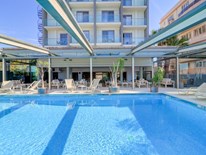 Bomo Palace Hotel
Bomo Palace Hotel- Region:
- Athens Glyfada
- Rooms:
- 76
Fully renovated in 2018, BOMO Palace Hotel is conveniently located on the beachfront of Glyfada, Athens. Neat architecture and a minimalistic decoration create a cozy atmosphere where you can enjoy a drink by the pool or a walk by the beach. The center of the luxurious Glyfada district is within a walking distance should you desire to shop for famous brands. Piraeus Port is very close, so you can...Entire year -
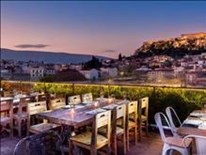 Aparthotel 3*360 Degrees Hotel
Aparthotel 3*360 Degrees Hotel- Region:
- Athens
- Rooms:
- 20
Small modern hotel in the center of Athens. Choice of rooms, internet, restaurant, bar, quality service.Entire year


